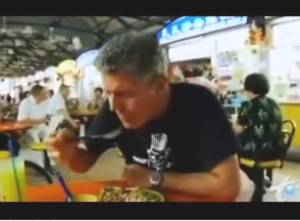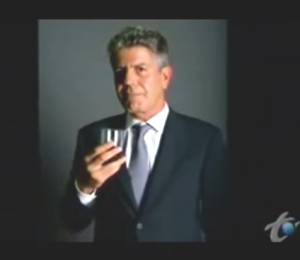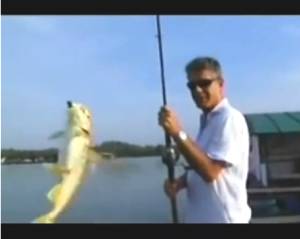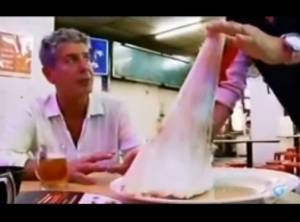Anthony Bourdain is in Singapore to uncover its rich cuisine. Singapore is serious about food and offers up a cuisine like no other. The cuisine of Singapore borrows heavily from Chinese, Indian, Malaysian and Indonesian cuisines, and Anthony dives in head-first.
Introduction:
Singapore is a city-state in Southeast Asian off the southern tip of the Malay Peninsula. An island country made up of 63 islands, it is separated from Malaysia by the Straits of Johor to its north and from Indonesia by the Singapore Strait to its south. The country is highly urbanised with very little primary rainforest remaining.
Singapore had been a part of various local empires since it was first inhabited in the 2nd century AD. It hosted a trading post of the East India Company in 1819 with permission from the Sultanate of Johor. The British obtained sovereignty over the island in 1824 and Singapore became one of the British Straits Settlements in 1826. Occupied by the Japanese in World War II, Singapore declared independence, uniting with other former British territories to form Malaysia in 1963, although it was separated from Malaysia two years later.
Economy:
Since then, it has had a massive increase in wealth, and is one of the Four Asian Tigers. Singapore is the world's fourth leading financial centre, and its port is one of the five busiest ports in the world. The economy depends heavily on exports and refining imported goods, especially in manufacturing, which constitutes roughly 26% of Singapore's GDP. Singapore's foreign policy is directed to maintaining a secure environment in Southeast Asia as well as the territories that surround it. An underlying principle is regional political and economic stability in the region.
Demographics:
As of 2010, 5.1 million people live in Singapore, of whom 3.2 million (64%) are Singapore citizens while the rest (36%) are permanent residents or foreign workers. 2.9 million people (57%) were born in Singapore while the rest are foreign-born. 74.2% of residents were of Chinese descent, 13.4% of Malay descent, and 9.2% of Indian descent. Buddhism is the most widely practised religion in Singapore, with 33% of the resident population declaring themselves adherents at the most recent census. The next largest religions, in order of size, are Christianity, Islam, Taoism and Hinduism.
Racial and religious harmony is regarded by the government as a crucial part of Singapore's success and played a part in building a Singaporean identity. Due to the many races and cultures in the country, there is no single set of culturally acceptable behaviors.
There are four official languages: English, Chinese, Malay, and Tamil. English is the first language of the nation and is the language of business, government and medium of instruction in schools. Chinese is the most common home language, used by about half of all Singaporeans. Singaporean Mandarin is the most common version of Chinese in the country.
Tourism:
Tourism forms a large part of the economy, and 11.6 million tourists visited the country in 2010, over twice Singapore's total population. To attract more tourists, the government legalized gambling and allowed two casino resorts to be developed. Singapore is promoting itself as a medical tourism hub: about 200,000 foreigners seek medical care there each year, and Singapore medical services aim to serve one million foreign patients annually by 2012.
Singapore's food in itself has been heavily promoted as an attraction for tourists alongside shopping. The multiculturalism of local food, the ready availability of international cuisine, and their wide range in prices to fit all budgets at all times of the day and year helps create a "food paradise" to rival other contenders claiming the same.
In Singapore, food is viewed as crucial to national identity and a unifying cultural thread; Singaporean literature declares eating as a national pastime and food, a national obsession. Food is a frequent topic of conversation among Singaporeans. This phenomenon makes the cuisine of Singapore a cultural attraction. Most prepared food bought outside the home is eaten at hawker centres or food courts, examples of which include Lau Pa Sat and Newton Food Centre, rather than at actual restaurants. These hawker centres are abundant and cheap, encouraging a large consumer base.
Cuisine:
As Singapore is a small country with a high population density, land is a scarce resource devoted to industrial and housing purposes. Most produce and food ingredients are imported, although there is a small group of local farmers who produce some leafy vegetables, fruit, poultry, and fish.
Singapore's geographical position connects it to major air and sea transport routes and thus allows it to import a variety of food ingredients from around the world, including costly seafood items such as sashimi from Japan. Singapore's consumption of fish is estimated to be 100,000 tons per year. In 2010, there were 106 licensed coastal floating fish farms in Singapore, most along the Johor Straits, producing 3,235 tons of fish. They accounted for 4-5% of the fish consumed annually in Singapore.
Episode Recap:
Anthony Bourdain starts his journey at a typical Singapore food court. He points out that unlike in most countries where you normally only find generic fair at such establishments, at food courts in Singapore, you find gourmet quality food.
 Tian Tian Hainanese Chicken Rice: Anthony orders the very popular Singaporean dish, Hainanese chicken rice at the Tian Tian Hainanese Chicken Rice stand at the Maxwell Food Centre. This is arguably the best place in Singapore to get it The dish is usually served with several dips, including chili sauce, pounded ginger, and dark soy sauce.
Tian Tian Hainanese Chicken Rice: Anthony orders the very popular Singaporean dish, Hainanese chicken rice at the Tian Tian Hainanese Chicken Rice stand at the Maxwell Food Centre. This is arguably the best place in Singapore to get it The dish is usually served with several dips, including chili sauce, pounded ginger, and dark soy sauce.
The prevalence of stalls and food courts selling Hainanese chicken rice as their primary specialty in Singapore underscores the dish's unrivaled popularity amongst Singaporeans and overseas visitors. Hainanese chicken rice is considered as the "national dish" of Singapore.
StraitsKitchen: Located inside the Grand Hyatt Singapore, where Anthony is staying, the StraitsKitchen is a Singapore-inspired restaurant presenting the best of local cuisine. Anthony clarifies that although he and his crew normally balk at eating in the restaurants of major chain hotels, in Singapore, the food is usually exceptional even in these hotels since they've essentially copied the same style as the competing food courts. So while Anthony in this case makes this one exception, he indulges in an endless parade of flavors—everything from Chinese to Malay to Indian cuisine. All the dishes are authentic, the food is fresh, and everything is made from scratch by authentic specialists in their respective cuisine.
 Russel Wong Studio: Anthony is always complaining about how he never gets paid for all his free endorsements. Russel Wong is a Singapore-born Hollywood celebrity photographer, and Anthony hopes a photo shoot in with his friend will land him some commercial endorsements. Since Russel works from home, while they work, or rather joke around, his wife Judy prepares Hokkien hae mee, a classic Singaporean speciality and Chinese favorite.
Russel Wong Studio: Anthony is always complaining about how he never gets paid for all his free endorsements. Russel Wong is a Singapore-born Hollywood celebrity photographer, and Anthony hopes a photo shoot in with his friend will land him some commercial endorsements. Since Russel works from home, while they work, or rather joke around, his wife Judy prepares Hokkien hae mee, a classic Singaporean speciality and Chinese favorite.
Hokkien hae mee is a dish of egg noodles in a fragrant stock made from both fresh shrimp and pork. It is garnished with prawns, fishcake, leafy greens, pork ribs, squid, crisp deep-fried shallots, spring onions and fresh lime. The dish is served with sliced red chili, light soy sauce and sambal.
Master Soon Reflexology Health: Anthony decides to rebalance his Yin & Yang Qi with an appointment at Master Soon Reflexology Health. Anthony admits although he's skeptical, he really could use a great foot massage. After his treatment, Anthony's not only a new convert, but he feels great
Reflexology, or zone therapy, is an alternative medicine involving the physical act of applying pressure to the feet, hands, or ears with specific thumb, finger, and hand techniques without the use of oil or lotion. It is based on what reflexologists claim to be a system of zones and reflex areas that they say reflect an image of the body on the feet and hands, with the premise that such work effects a physical change to the body.
There's no consensus among reflexologists on how reflexology is supposed to work; a unifying theme is the idea that areas on the foot correspond to areas of the body, and that by manipulating these one can improve health through one's invisible life force, or Qi.
Golden Mile Food Center: Completely disregarding Master Soon's dietary recommendations, Anthony heads straight to yet another hacker center—Golden Mile Food Center—for one of his favorite Singaporean dishes, sup tulang ("bone soup"). He's joined by Bobby Chinn, globe-trotting celebrity chef and restauranteur. Sup tulang is a local Mamak (Tamil Muslim) dish of mutton or beef bones stewed in an intensely red spicy sweet and sour sauce. You suck out the tasty bone marrow, occasionally using a straw. It's high in the kind of fat that's actually good for you.
 Pier Fishing: Anthony joins his friend Iskandar, a professional sport fisherman and bass player for the local band Energy, for some pier fishing at one of the many fish farms found along the Johor Straits. They joke about how on most episodes they usually have to resort to using "stunt fish" because their luck is notoriously bad. Iskandar suggests Anthony should consider dynamite fishing, then suddenly a catch! Being of Malaysian descent, Iskandar treats Anthony to several Malay dishes. They start off with some fresh rabe prawns with mint and garlic, followed by grilled fresh crab, horseshoe crab, flower crab, and curry ikan duri (catfish curry).
Pier Fishing: Anthony joins his friend Iskandar, a professional sport fisherman and bass player for the local band Energy, for some pier fishing at one of the many fish farms found along the Johor Straits. They joke about how on most episodes they usually have to resort to using "stunt fish" because their luck is notoriously bad. Iskandar suggests Anthony should consider dynamite fishing, then suddenly a catch! Being of Malaysian descent, Iskandar treats Anthony to several Malay dishes. They start off with some fresh rabe prawns with mint and garlic, followed by grilled fresh crab, horseshoe crab, flower crab, and curry ikan duri (catfish curry).
Aurum: Anthony is joined by his friends Marcia and Melissa for dinner at Aurum, Singapore's first foray into the brave new world of molecular cuisine. Aurum is just the kind of hip, stylish, of-the-moment place every sophisticated city requires these days. Yet, the hospital-chic theme kind of puts Anthony off. You eat your meal on a surgical-steel operating table, seated in a gold-plated wheelchair, and the meals are prepared under operating-room lights. Anthony and his friends found a few items among the 14-course menu to be delicious and smartly executed, like the chef's reinvention of the insalata caprese—a mozzarella ball injected with a shot of gazpacho, and their bold dashi soup with olive-oil soba.
Molecular gastronomy is a discipline that studies the physical and chemical processes that occur while cooking. It seeks to investigate and explain the chemical reasons behind the transformation of ingredients, as well as the social, artistic and technical components of culinary and gastronomic phenomena in general. "Molecular gastronomy" also refers to a modern style of cooking, which takes advantage of innovations from the scientific discipline. Pioneering chefs who are often associated with molecular gastronomy because of their embrace of science include Heston Blumenthal, Ferran Adrià, and Wylie Dufresne, to name just a few.
 Tian Jin Hai Seafood: Anthony meets up with his friend KF Seetoh, editor and creator of Makansutra eating guide and website at yet another hacker center—Jackson Centre Kopitiam. They go to the Tian Jin Hai Seafood stall for dish that's still relatively new even to Singaporeans—freshly steamed shark head, topped with soy, sesame, ginger, coriander. To Anthony's surprise it was not only delicious but quite tender. He also tries another local delicacy—Singapore chilli crab. Mud crabs are commonly used and are stir-fried in a semi-thick, sweet and savory tomato and chili based sauce. But what's so special about the dish at this particular hawker stall is these mud crabs are monster-size crabs imported from Sri Lanka. They reputedly grow so large because they feed on corpses of partially cremated bodies left along the banks of the Ganges. This doesn't seem to put Anthony off in the least bit.
Tian Jin Hai Seafood: Anthony meets up with his friend KF Seetoh, editor and creator of Makansutra eating guide and website at yet another hacker center—Jackson Centre Kopitiam. They go to the Tian Jin Hai Seafood stall for dish that's still relatively new even to Singaporeans—freshly steamed shark head, topped with soy, sesame, ginger, coriander. To Anthony's surprise it was not only delicious but quite tender. He also tries another local delicacy—Singapore chilli crab. Mud crabs are commonly used and are stir-fried in a semi-thick, sweet and savory tomato and chili based sauce. But what's so special about the dish at this particular hawker stall is these mud crabs are monster-size crabs imported from Sri Lanka. They reputedly grow so large because they feed on corpses of partially cremated bodies left along the banks of the Ganges. This doesn't seem to put Anthony off in the least bit.
Beer Buddies: Anthony and Seetoh join several of his retired friends for some laughs and a few beers at another stall. Compared to their Western counterparts, these men who are in their 70's don't look much older than Anthony who is only 50. They share the secret to their longevity—lots of beer and pork and no exercise; three of Anthony's most favorite things in life.
Episodes:
 |
ARGENTINA: From the Tango to paragliding to cattle rustling to trekking along icy glaciers, Anthony experiences it all. |
 |
AUSTRALIA: Melbourne has been described as San Francisco without the fog. Anthony is off to discover what makes it so special. |
 |
BERLIN: Anthony finds himself in Berlin, a city that is for him both good and evil, Eastern and Western, repulsive and appealing. |
 |
BRAZIL: Some say São Paulo feels like LA threw up on NYC. But Anthony's back for the great food and its welcoming people. |
 |
CALCUTTA & BOMBAY: Anthony revisits his love for India's vibrant culture, cuisine & communities with a trip to Kolkata & Mumbai. |
 |
COLOMBIA: A bright and beautiful country that has gone from drug capital to food capital. Anthony explores its unique cuisine. |
 |
EGYPT: Anthony skips the long lines and tour buses, and visits with Egyptian locals to get a taste for what it means to be Egyptian. |
 |
GHANA: Anthony heads to Ghana, West Africa, a land of old forts and slave castles, and a culture filled with great food and music. |
 |
GREEK ISLES: Anthony is on a culinary odyssey to discover if Greece really does have the world's healthiest diet. |
 |
HONG KONG: A wonder-land of colors, lights and speed, a perfect marriage of modern and traditional, and home to great Asian cuisine. |
 |
IRELAND: Ireland's steeped in history and traditions, both oral & written. Anthony dispels the myths that it has the worst food on the planet. |
 |
JAMAICA: Jamaica is a vibrant, colorful land full of resorts and reggae music. Anthony is there to uncover the lesser-known Jamaica. |
 |
KOREA: Anthony gives in to his employee's pressure to visit Korea and, next thing you know, they're in Seoul and the adventure begins. |
 |
MEXICO: Carlos, a head chef in NYC and good friend, gives Anthony a culinary tour of his hometown Puebla and nearby Mexico City. |
 |
OSAKA (Japan): Anthony learns all about kuidaore, which means to bankrupt oneself with extravagance in food and drink! |
 |
PARIS: In this very first episode of the series, Anthony heads to the "City of Light" to show, at least the Americans, why the French don't suck. |
 |
PERU: Anthony is on a mission to obtain personal enlightenment in a land of ancient culture, rich cuisine, and vibrant people. |
 |
QUEBEC (Canada): Anthony is off to Québec to indulge in one of his most hedonistic pleasures–foie gras (fatty duck liver). |
 |
RAJASTHAN (India): From gorgeous sights to enticing smells, Anthony explores the magical and delicious offerings of Rajasthan. |
 |
ROME: Anthony adopts the mindset of the Roman people–living a simple life and eating fresh, seasonal ingredients. |
 |
RUSSIA: Anthony explores Russia, where the food is hearty. Along the way he meets a former Cold War spy and Miss Russia. |
 |
SHANGHAI (China): Anthony is back in China. From Shanghai to Tibet, he searches for the mythical Shangri-La. |
 |
SICILY: Anthony starts his gastronomic tour through Sicily in style by sharing a spleen sandwich with Sicily's president. |
 |
SPAIN: According to Anthony, outside of Asia, Spain is the single greatest place for culinary achievement in the world. |
 |
TOKYO: Anthony is off to Tokyo in search of the relationship between a perfect piece of sushi and a perfect knife blade. |
 |
TUSCANY: Anthony travels to the beautiful Tuscan countryside to visit with friends and enjoy some homemade pasta that's out of this world. |
 |
URUGUAY: Anthony and his brother are on a mission to connect with their roots in Uruguay after learning that Bourdains once settled here. |
 |
VANCOUVER (Canada): Anthony visits Vancouver, home to a thriving film industry, gorgeous scenery, and an evolving food scene. |
Contact Us | Shop | Sitemap | Join Our Team | Investors | Advertise | Web Design Services
Community | Foodies' Choice | Meetup Groups | Chat | Blogs | Forums | Submit Your Site | Resources
